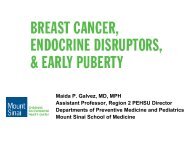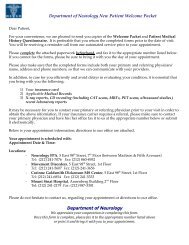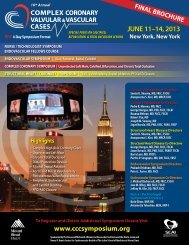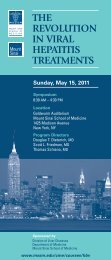CARDIAC CATH LAB - Mount Sinai Hospital
CARDIAC CATH LAB - Mount Sinai Hospital
CARDIAC CATH LAB - Mount Sinai Hospital
Create successful ePaper yourself
Turn your PDF publications into a flip-book with our unique Google optimized e-Paper software.
INNOVATIONS<br />
Samin K. Sharma, MD<br />
Director, Cardiac Cath Lab & Intervention, on<br />
Complex Coronary Interventions<br />
Live footage of<br />
interventions,<br />
including ULM<br />
procedures, can<br />
be viewed at<br />
www.ccclivecases.org.<br />
<strong>Mount</strong> <strong>Sinai</strong> <strong>Hospital</strong>’s cath lab ranks<br />
as the top-volume PCI center in New<br />
York State, based on Department of<br />
Health statistics. The cath lab has<br />
seen total interventions rise by 12<br />
percent in the past year, coupled with<br />
further declines in already low rates<br />
of death and major complications.<br />
These are statistics to be proud of<br />
indeed! We can attribute our success<br />
to the constant efforts on the part<br />
of every member of our staff in<br />
advancing clinical practice through<br />
well-designed innovations. Below are brief descriptions of three such<br />
recent innovations that are contributing both to improved<br />
understanding of CAD and to patient outcomes after intervention.<br />
Unprotected Left Main Disease<br />
Historically, CABG had been the treatment of choice for unprotected<br />
left main (ULM) disease, supported by the ACC/AHA guidelines. Even<br />
recommendations updated in 2007 called PCI “consistently not helpful<br />
and possibly harmful” in treating ULM cases. In the era of bare metal<br />
stents, patients with ULM disease treated by PCI definitely did not do<br />
as well over the long term as patients who underwent CABG. Since the<br />
introduction of drug-eluting stents (DES), however, the use of PCI has<br />
been expanded for selected patients with ULM lesions. There was a lack<br />
of large, randomized studies to provide sufficient clinical data upon<br />
which to make changes in the practice guidelines and make the use<br />
of PCI broadly acceptable for ULM revascularization. The SYNTAX Trial<br />
was designed to examine that premise, comparing CABG with thee<br />
TAXUS® DES. In sum, the 1,800 patients who participated in the trial<br />
had complex multivessel disease including a subset of 705 patients<br />
with ULM disease. When the SYNTAX trial results were analyzed they<br />
16 <strong>Mount</strong> <strong>Sinai</strong> <strong>Hospital</strong> Cardiac Cath Lab



![December 2, 2012 [PDF] - Mount Sinai Hospital](https://img.yumpu.com/51092274/1/190x245/december-2-2012-pdf-mount-sinai-hospital.jpg?quality=85)
![January 21, 2013 [PDF] - Mount Sinai Hospital](https://img.yumpu.com/50916550/1/190x245/january-21-2013-pdf-mount-sinai-hospital.jpg?quality=85)

![February 3, 2013 [PDF] - Mount Sinai Hospital](https://img.yumpu.com/50584982/1/190x245/february-3-2013-pdf-mount-sinai-hospital.jpg?quality=85)
![March 18, 2012 [PDF] - Mount Sinai Hospital](https://img.yumpu.com/50462098/1/190x245/march-18-2012-pdf-mount-sinai-hospital.jpg?quality=85)



![Partners Program Guide [PDF] - Mount Sinai Hospital](https://img.yumpu.com/49411954/1/190x245/partners-program-guide-pdf-mount-sinai-hospital.jpg?quality=85)

![March 19 - April 1, 2012 [PDF] - Mount Sinai Hospital](https://img.yumpu.com/48990923/1/190x245/march-19-april-1-2012-pdf-mount-sinai-hospital.jpg?quality=85)
![PGY-1 Residency Application [PDF] - Mount Sinai Hospital](https://img.yumpu.com/48577701/1/190x245/pgy-1-residency-application-pdf-mount-sinai-hospital.jpg?quality=85)


